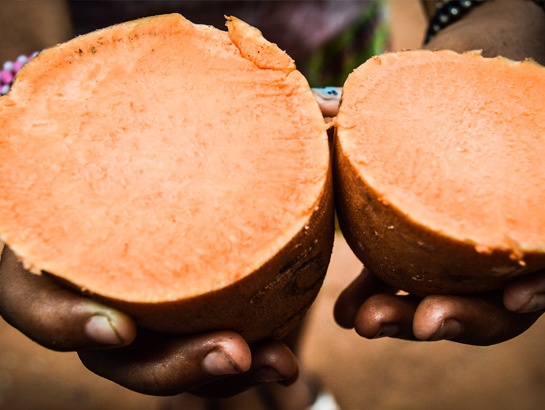An initiative that at first simply sought to increase the productivity and the visual appeal of sweet potatoes has resulted in a biofortification strategy to improve the nutrition of southern Brazil.
Vitamin A deficiency is the most common cause of preventable childhood blindness among children in poor areas of southern Brazil. Families in the region meet a large part of their daily needs for vitamin A by consuming yellow and orange vegetables such as sweet potatoes, which contain carotenoids that the body converts into vitamin A.
Because of its agronomic traits and its ubiquity in the Brazilian diet, the sweet potato was chosen by a group of researchers as one of the vegetables to include in the genetic improvement plan that in 2011 resulted in BRS Amélia, a variety biofortified with carotenoids.
The BioFORT Network (Red BioFORT) was created in Brazil in 2003 with the aim of developing foods rich in micronutrients, particularly provitamin A.
Led by Embrapa and supported by HarvestPlus—a world leader in biofortification—and the Alliance of Bioversity International and CIAT, the network is made up of universities, crop producers, and public and private organizations committed to food security.
Drawing on two decades of collaborative research, the network turned to crop biofortification as a strategy to improve the nutrition of the population. The development of BRS Amélia took almost 20 years of teamwork. The cross between the best specimens from the germplasm bank produced the variety with the highest carotenoid content and the best agronomic performance.
To promote acceptance of BRS Amélia, the network invited beneficiaries to participate in the development process and carry out tests and validations on their farms. Participants gathered in a series of workshops where they learned good crop management practices and tasted the new sweet potato in order to assess its acceptability. The network licensed the multiplication of materials and guaranteed the genetic integrity and phytosanitary conditions for cultivation on farms. The project also included the training of other sectors of the community, especially school cooks.
Finally, the project promoted the development of value-added products based on BRS Amélia, such as chips, baby sweet potatoes, cookies, sweets, and ice cream, among others.
“Today, the orange-fleshed sweet potato is an important part of a family’s diet and improves the income of small farmers,” said Andrea Mattos, a Brazilian farmer.
The BRS Amélia sweet potato has had a noticeably positive impact on the region’s population, who consumed varieties with negligible carotenoid content until a decade ago. BRS Amélia surplus is sold at local fairs and it supplies stock to institutional food procurement programs. This commercial channel promotes access to more-nutritious food and improves the economy of farming families, helping to reduce rural flight.
Between 2011 and 2018, the cultivated area increased from 2 to 2,000 hectares. Crop yield doubled in relation to the traditional variety, reaching 32,000 kg/ha with the BRS Amélia variety. A new variety of biofortified sweet potato suitable for tropical environments is planned for release in the northeast, where the vegetable is widely cultivated.
